how to color formborder color in vb.net?
I want color formborder equal to backcolor 45, 66, 50.
What do I mean in the yellow circle in the screenshot below?.
 note : I use visual studio 2010
Thanks
roy
note : I use visual studio 2010
Thanks
roy
- 693
- 2
- 11
-
It's not easy and straightforward. It involves handling native windows messages like [`WM_NCPAINT`](https://learn.microsoft.com/en-us/windows/win32/gdi/wm-ncpaint?WT.mc_id=DT-MVP-5003235) and calling native windows function. Probably the easiest way of doing it, is using a borderless form, and using a toolbar or menu as titlebar. – Reza Aghaei Dec 27 '21 at 10:13
-
@RezaAghaei , if it can with code it's better if indeed another solution can you guide me? – roy Dec 27 '21 at 13:41
-
There are many similar questions in stackoverflow, but I couldn't find an example of a custom titlebar, so I posted the custom titlebar using VB.NET. – Reza Aghaei Dec 27 '21 at 23:32
-
My answer is using syntax of the newer versions of language. I do not have VS 2010, but I assume you can modify it on you machine. – Reza Aghaei Dec 27 '21 at 23:44
-
@RezaAghaei , ,thank you for your reply but I have an error. FindForm()' >>Value of type 'System.Windows.Forms.Form' cannot be converted to 'System.Drawing.Image' , FindForm()>>Value of type 'System.Windows.Forms.Form' cannot be converted to 'String',f.Icon >> Value of type 'System.Drawing.Icon' cannot be converted to 'System.Drawing.Image' and ? >> The '?' character cannot be used here . – roy Dec 28 '21 at 12:45
-
As I mentioned in the comments, I have written the answer with VS2019 and I don't have VS 2010, but anyhow, I modified it to the extent that I could, hope it works on your machine. But it's working perfectly in my environment. – Reza Aghaei Dec 28 '21 at 15:31
-
@RezaAghaei , Thanks for your reply. This runs perfectly and I have uploaded a screenshot of the original form that I marked round in blue, first at the top can it be the same size as the original size? If it could be better when it has a long distance for Movable and second at the bottom can it be sizeable? Because I try not to be sizeable. – roy Dec 29 '21 at 02:10
-
If you want to continue using this approach, then the next problem that you need to solve is allowing the user to resize the form. In this case, I'd rather to not change the answer as the post is long enough and its focus is on the titlebar. You can do some research and try to apply the solutions that you find in stackoverflow, for example [this one](https://stackoverflow.com/a/52094960/3110834). Later if you have any further question, please feel free to ask a new question and I'll try to help if I have any idea. – Reza Aghaei Dec 29 '21 at 10:17
-
@RezaAghaei , Okay thank you very much. you are my teacher and master .i have latest post can you help me ? https://stackoverflow.com/questions/70519360/how-to-filter-datagridview-with-combobbox-without-query-and-with-invisible-colum – roy Dec 29 '21 at 12:25
-
No problem @Roy. I put some comments under your other post. – Reza Aghaei Dec 29 '21 at 14:57
1 Answers
As I mentioned in the comment, it's not a trivial thing to do. It involves handling native windows messages like WM_NCPAINT and calling native windows API function, and painting the titlebar and handling different situations yourself.
It probably will be easier if you use a borderless form, and the show a custom titlebar yourself. As an idea for a custom titlebar, you can use a MenuStrip.
There are many similar questions in stackoverflow, but I couldn't find an example of a custom titlebar (specially in VB.NET), so I posted the custom titlebar using VB.NET here.
Custom Titlebar using ManuStrip
In this example, I've created a custom titlebar class based on the menu strip, which supports the following features:
- It has Close, Maximize/Restore, and Minimize buttons
- It shows the Form's icon and text
- Double click on the titlebar works and it maximizes or restores the form
- Rightclick on the titlebar works and it shows system menu
- Doubleclick on icon works and it closes the form
- It's Movable; you can move the form by dragging the titlebar
I cannot tell it's a full-fledge titlebar, but it's a good proof of concept:
You can modify the appearance and behaviors based on your requirements. Here is the code:
Imports System.Runtime.InteropServices
Public Class CustomTitleBar
Inherits MenuStrip
Private CloseButton As ToolStripMenuItem
Private MaximizeButton As ToolStripMenuItem
Private MinimizeButton As ToolStripMenuItem
Private IconLabel As ToolStripLabel
Private TextLabel As ToolStripLabel
Public Sub New()
MyBase.New()
CloseButton = New ToolStripMenuItem()
MaximizeButton = New ToolStripMenuItem()
MinimizeButton = New ToolStripMenuItem()
IconLabel = New ToolStripLabel()
TextLabel = New ToolStripLabel()
'IconLabel
IconLabel.Alignment = ToolStripItemAlignment.Left
IconLabel.AutoSize = False
IconLabel.Name = "IconLabel"
IconLabel.Size = New Size(64, 64)
IconLabel.Text = ""
'TextLabel
TextLabel.Alignment = ToolStripItemAlignment.Left
TextLabel.AutoSize = True
TextLabel.Name = "TextLabel"
TextLabel.Text = ""
'CloseButton
CloseButton.Alignment = ToolStripItemAlignment.Right
CloseButton.AutoSize = False
CloseButton.Name = "CloseButton"
CloseButton.Size = New Size(64, 64)
CloseButton.Text = "✕"
AddHandler CloseButton.Click, AddressOf CloseButton_Click
'MaximizeButton
MaximizeButton.Alignment = ToolStripItemAlignment.Right
MaximizeButton.AutoSize = False
MaximizeButton.Name = "MaximizeButton"
MaximizeButton.Size = New Size(64, 64)
MaximizeButton.Text = "⬜"
AddHandler MaximizeButton.Click, AddressOf MaximizeButton_Click
'MinimizeButton
MinimizeButton.Alignment = ToolStripItemAlignment.Right
MinimizeButton.AutoSize = False
MinimizeButton.Name = "MinimizeButton"
MinimizeButton.Size = New Size(64, 64)
MinimizeButton.Text = "―"
AddHandler MinimizeButton.Click, AddressOf MinimizeButton_Click
GripStyle = ToolStripGripStyle.Hidden
Me.Padding = New Padding(1)
ImageScalingSize = New System.Drawing.Size(32, 32)
Me.AutoSize = True
Me.Dock = DockStyle.Top
Me.TabStop=False
Items.Add(IconLabel)
Items.Add(TextLabel)
Items.Add(CloseButton)
Items.Add(MaximizeButton)
Items.Add(MinimizeButton)
End Sub
private sub MinimizeButton_Click(sender As Object, e As EventArgs)
Dim f = FindForm()
If (f Is Nothing) Then Return
f.WindowState = FormWindowState.Minimized
End sub
private sub MaximizeButton_Click(sender As Object, e As EventArgs)
Dim f = FindForm()
If (f Is Nothing) Then Return
If (f.WindowState = FormWindowState.Normal) Then
f.WindowState = FormWindowState.Maximized
ElseIf f.WindowState = FormWindowState.Maximized Then
f.WindowState = FormWindowState.Normal
End If
End sub
private sub CloseButton_Click(sender As Object, e As EventArgs)
Dim f = FindForm()
If (f Is Nothing) Then Return
f.Close()
End sub
Protected Overrides Sub OnMouseDown(e As MouseEventArgs)
MyBase.OnMouseDown(e)
Dim f = FindForm()
If (f Is Nothing) Then Return
If (e.Button = MouseButtons.Left) Then
If (e.Clicks = 1 AndAlso _
e.Location.X < MinimizeButton.Bounds.X AndAlso _
e.Location.X > IconLabel.Bounds.Right) Then
ReleaseCapture()
SendMessage(f.Handle, WM_NCLBUTTONDOWN, HT_CAPTION, 0)
End If
ElseIf (e.Button = MouseButtons.Right) Then
Dim menu = GetSystemMenu(f.Handle, False)
Dim command = TrackPopupMenu(menu, _
TPM_RETURNCMD + TPM_LEFTBUTTON + TPM_RIGHTBUTTON, _
MousePosition.X, MousePosition.Y, IntPtr.Zero, _
f.Handle, IntPtr.Zero)
If (command > 0) Then
SendMessage(f.Handle, _
WM_SYSCOMMAND, command, IntPtr.Zero)
End If
End If
End Sub
Protected Overrides Sub OnMouseDoubleClick(e As MouseEventArgs)
MyBase.OnMouseDoubleClick(e)
Dim f = FindForm()
If (f Is Nothing) Then Return
If (e.X < IconLabel.Bounds.Right) Then
f.Close()
ElseIf (f.WindowState = FormWindowState.Normal) Then
f.WindowState = FormWindowState.Maximized
ElseIf f.WindowState = FormWindowState.Maximized Then
f.WindowState = FormWindowState.Normal
End If
End Sub
Protected Overrides Sub OnParentChanged(e As EventArgs)
MyBase.OnParentChanged(e)
Dim f = FindForm()
If (f Is Nothing) Then Return
UpdateIcon()
UpdateText()
AddHandler f.TextChanged, AddressOf Parent_TextChanged
End Sub
Protected Overrides Sub OnHandleCreated(e As EventArgs)
MyBase.OnHandleCreated(e)
UpdateIcon()
UpdateText()
End Sub
Private sub Parent_TextChanged(sender As Object, e As EventArgs)
UpdateText()
End sub
Private sub UpdateIcon()
Dim f = FindForm()
If (f Is Nothing) Then Return
If(f.Icon IsNot Nothing)
IconLabel.Image = f.Icon.ToBitmap()
End If
End sub
Private sub UpdateText()
Dim f = FindForm()
If (f Is Nothing) Then Return
TextLabel.Text = f.Text
End sub
Private Const TPM_LEFTBUTTON As Integer = &H0
Private Const TPM_RIGHTBUTTON As Integer = &H2
Private Const TPM_RETURNCMD As Integer = &H100
Private Const WM_SYSCOMMAND As Integer = &H112
<DllImport("user32.dll")> _
Private Shared Function GetSystemMenu(hWnd As IntPtr, _
bRevert As Boolean) As IntPtr
End Function
<DllImport("user32.dll")> _
Private Shared Function TrackPopupMenu( _
hMenu As IntPtr, uFlags As Integer, _
x As Integer, y As Integer, nReserved As Integer, _
hWnd As IntPtr, prcRect As IntPtr) As Integer
End Function
Private Const WM_NCLBUTTONDOWN As Integer = &HA1
Private Const HT_CAPTION As Integer = &H2
<DllImport("User32")> _
Private Shared Function SendMessage(hWnd As IntPtr, msg As Integer, _
wParam As Integer, lParam As Integer) As Integer
End Function
<DllImport("User32")> _
Private Shared Function ReleaseCapture() As Boolean
End Function
End Class
After you build the project, you can drop an instance of CustomTitleBar to the form. To support showing system context menu, you need to add the following code to your form:
Public Class Form1
Private Const WS_SYSMENU As Integer = &H80000
Private Const WS_MINIMIZEBOX As Integer = &H20000
Private Const WS_MAXIMIZEBOX As Integer = &H10000
Protected Overrides ReadOnly Property CreateParams _
As System.Windows.Forms.CreateParams
Get
Dim p = MyBase.CreateParams
p.Style = WS_SYSMENU + WS_MINIMIZEBOX + WS_MAXIMIZEBOX
Return p
End Get
End Property
End Class
- 120,393
- 18
- 203
- 398
-
,thank you for your reply but I have an error. `FindForm()' >>Value of type 'System.Windows.Forms.Form' cannot be converted to 'System.Drawing.Image' `, `FindForm()`>>Value of type 'System.Windows.Forms.Form' cannot be converted to 'String',`f.Icon` >> Value of type 'System.Drawing.Icon' cannot be converted to 'System.Drawing.Image' and `?` >> The '?' character cannot be used here . – roy Dec 28 '21 at 03:05

